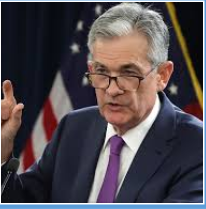Investorerne begynder at fokusere mere end tidligere på den amerikanske centralbank, der holder møde i denne uge. Hvornår ser Fed-chefen Powell tegn på en øget inflation? Hvornår vil Fed begynde at slække på sine obligationsopkøb (den såkaldte tapering)? Ser Fed tegn på en boble på aktiemarkedet, hvor price-earning er på 22, og hvor kurserne nærmer sig niveauet fra dotcom-krisen? Flere investorer venter udspil fra centralbanken i juni.
Investor questions for the Fed: what about inflation, bond buying and rates?
Investors will be scrutinizing the Federal Reserve’s comments at the close of its policy meeting this week, which will come on Wednesday, for insight into the central bank’s thinking on inflation, bond purchases and risks to the financial system posed by soaring asset prices.
Here are some questions investors may have:
WHERE IS INFLATION HEADED?
Trillions of dollars in federal stimulus spending coupled with an economic reopening as more Americans get vaccinated against the coronavirus has investors staring at the specter of overheating prices.
The Federal Reserve has said it expects some inflationary pressures, but predicts it will be temporary and not enough to warrant interest rate hikes. After a decade of low inflation, the Fed is now aiming for inflation moderately above 2%.
The Fed’s ability to explain away any potential rise in inflation has big implications for various asset classes, including stocks and bonds.
IS TAPERING ON THE HORIZON?
The Fed has pledged to continue its purchases of $120 billion a month in government debt until “substantial further progress” is made in the economic recovery from the coronavirus pandemic.
Fed Chair Jerome Powell on April 14 said the U.S. central bank expects to reduce its monthly bond purchases before it commits to a rate increase, although both changes could be months, if not years in the future. Investors will be watching to see if Powell says anything further about the timing of possible changes, said Roberto Perli, founding partner of Cornerstone Macro.
But strong economic data has investors looking for any signs the Fed may be starting to talk about tapering its purchases.
“I think the next two months of economic numbers are going to be quite good,” said Andy Brenner, head of international fixed income at National Alliance, who expects the Fed to comment on tapering as soon as June.
PRICEY STOCKS?
With U.S. stocks at record highs the Fed may have to field questions about whether valuations have gotten out of hand.
The S&P 500 index’s forward 12-month price-to-earnings ratio, at 22.3, is the highest since the dot-com days, raising concerns about a stock market bubble.
Earlier this month, Powell acknowledged that some asset prices are elevated relative to some historical metrics. Even so, the Fed has said it doesn’t see red flags in valuations.
The Fed’s first policy meeting after the high-profile implosion of New York fund Archegos Capital could invite fresh questions about excessive use of leverage and risks to the overall market.
Powell told CBS’s “60 Minutes” in April that the Fed was analyzing why some banks lost billions of dollars during the Archegos episode, but said systemic risks were unlikely.
ANY TWEAKS TO BOND BUYING?
After a dramatic selloff in the first quarter, Treasury yields have stabilized, obviating the need for the Fed to adjust asset purchases imminently to bolster prices. Still, Powell may be asked about a smaller recalibration by the Fed.
Earlier in April, Lorie Logan, an executive vice president at the New York Fed, said the regional bank may make minor adjustments to keep its Treasury purchases proportional to the outstanding supply of Treasuries and Treasury inflation-protected securities (TIPS).
The overall amount of debt purchased will stay the same, but the Fed is expected to decrease its purchases of TIPS and increase its purchases in the seven-to-20-year range. That will likely have the biggest effect on the 20-year yield, as demand for the maturity has been weak since it was reintroduced to the market last year.
Investors believe the changes may be reflected in the Fed’s next purchase schedule to be released on May 13.








